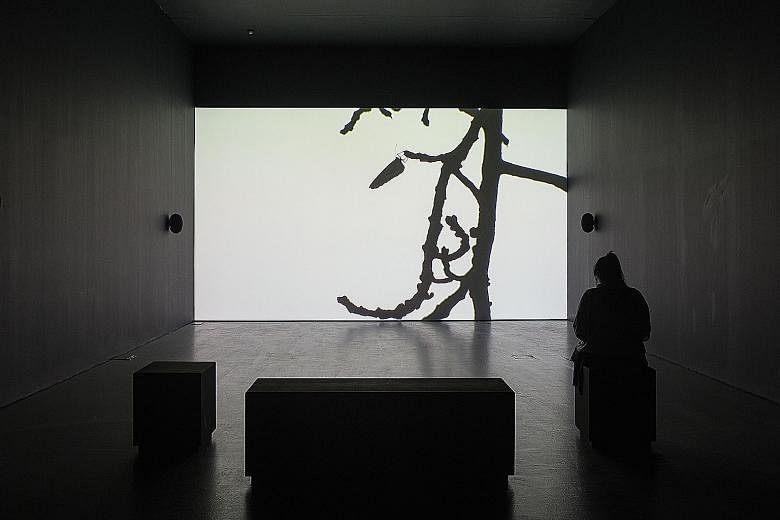Sites of violence in Odisha, east India, make up the film The Scene Of Crime (2011) by acclaimed artist Amar Kanwar.
Nearly all the locations that appear in it, Kanwar says, have been or will be repossessed for industrial development, threatening to upend the lives of inhabitants and the environment.
What is captured in the film, however, is lush idyll mostly devoid of people - the landscape before it is redrawn by construction.
The use of visual poetry to interrogate the harsh reality of clashes between residents and the authorities and corporations over development of the rural land is deliberate.
The 52-year-old artist, who lives in New Delhi, says he addresses violence through his art by finding ways to "look again, sense again, feel again and think again".
-
VIEW IT / THE SOVEREIGN FOREST
-
WHERE: NTU Centre for Contemporary Art Singapore, 43 Malan Road, Gillman Barracks
WHEN: Till Oct 9, noon to 7pm (Tuesday to Thursday and weekend), noon to 9pm (Friday), closed on Monday and open on public holiday
ADMISSION: Free
He was recently in Singapore to open the exhibition, The Sovereign Forest, at the NTU Centre for Contemporary Art Singapore. The show, which explores issues of justice, violence and politics of power through the land strife in Odisha, is done in collaboration with media activist Sudhir Pattnaik and designer-film-maker Sherna Dastur.
It was previously shown at prestigious exhibitions such as Documenta in Germany in 2012 and the Sharjah Biennial in the United Arab Emirates in 2013.
On his cool-headed yet engaged approach to socio-political violence, Kanwar says: "I cannot argue this to you. I cannot present a set of facts and explain this to you. I need to find another way to comprehend and share and talk about it."
His realisation came as, for more than a decade, he followed and filmed the conflicts erupting over ownership of Odisha's mineral-rich land.
He says: "After 10, 15 years, it's quite obvious that if a crime continues to take place, the question is 'How come?' Am I not getting it or does everybody want it to take place? Do they see it and like it, or do they not see it?"
He adds: "For me, if I experience something that disturbs me, I need to respond. I feel I have a responsibility. And I try to address the range of my own disturbances, my own comprehension and non-comprehension."
That inclination was what spurred the history graduate of University of Delhi to turn to film-making after he experienced two historic events in 1984 - the assassination of Indian Prime Minister Indira Gandhi by her Sikh bodyguards, resulting in mass retaliation against Sikhs in Delhi, and a toxic gas leak from a pesticide plant in Bhopal, which exposed thousands of people to poisonous chemicals and killed many others.
Among the first things he shot as a film-maker was the outpouring of public grief the day after the assassination of activist Shankar Guha Niyogi in 1991. The murder trial of Niyogi, who led a grassroots movement in the Indian state of Chhattisgarh fighting for better wages and working conditions, lasted more than a decade and most of the accused were eventually acquitted.
The film about Niyogi is included in the exhibition as part of the work, The Prediction (1991-2012) - a large handmade book with the film projected onto its pages.
Although the events took place in Odisha's neighbouring state, for Kanwar, it serves as evidence of an old crime scene and provides a counterpoint to the unfolding struggles in Odisha. He likens the exhibition's installation to a "constellation of evidence" at an actual crime scene where one gathers evidence to understand the crime.
Other pieces of poetic evidence include the story of the "counting sisters", mourners who keep count of those who die or disappear because of the land strife, and a selection of documents from an ongoing archive of evidence concerning the conflicts, including land records, tax receipts and petitions which are contributed by the public.
In the exhibition, too, is an installation that displays 272 species of rice - grown, collected and archived by schoolteacher turned farmer-and-seed activist Natabar Sarangi - as evidence of resistance against loss of agricultural diversity due to industrial development.
Shown alongside the seeds are small books such as the one that remembers farmers of Odisha who committed suicide because of oppression from agricultural corporations.
Professor Ute Meta Bauer, founding director of the contemporary art centre, says Kanwar's artistic approach raises the question of whether it might be possible for "an artistic language to communicate issues that are at stake in a different way" and what that might achieve.
The centre is therefore launching a six-week-long project, The Haze: An Inquiry, beginning on Friday, to extend Kanwar's method of working to the problem of the haze that affects South-east Asia. It will take the form of workshops, discussions and presentations led by a group of specialists from different disciplines including law, art, media and the sciences.
Prof Bauer says: "We are confronted daily with news that is devastating, complex, but very often, our response is 'Okay, facts understood, let's move on.'
"But that does not help us to change things. We have to find a different language that brings us into communication and also makes us understand that we are part of the story, not outside of it."


